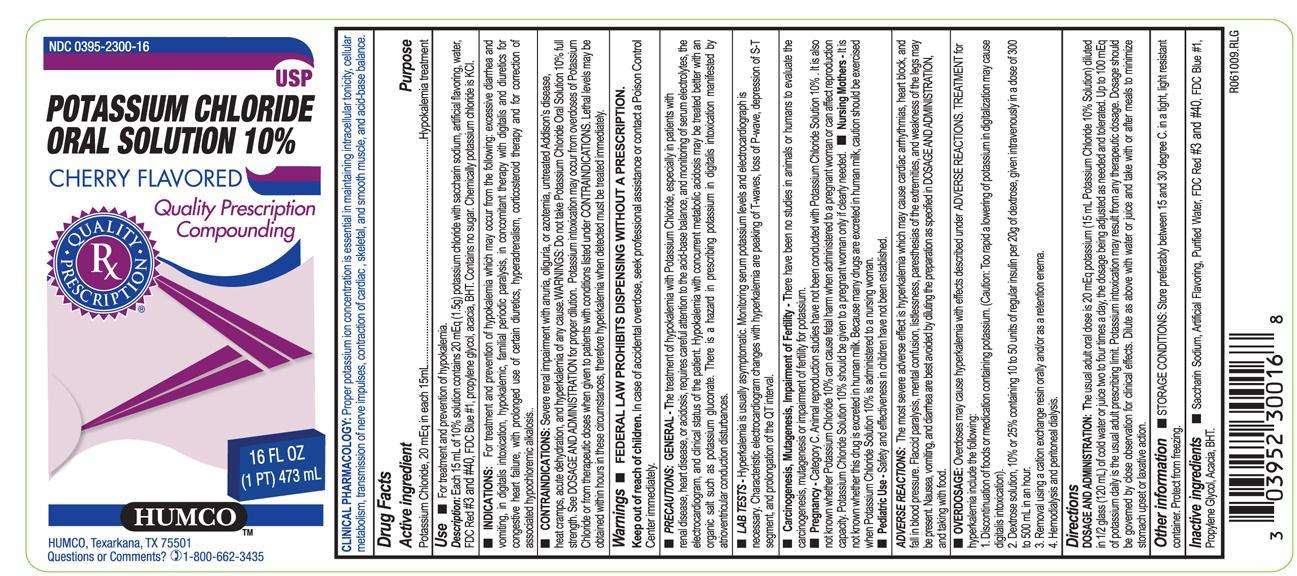HUMCO Potassium Chloride Oral Solution 10%
Humco Potassium Chloride Oral Solution 10%
FULL PRESCRIBING INFORMATION: CONTENTS*
- CLINICAL PHARMACOLOGY
- Active ingredient
- Purpose
- Use
- INDICATIONS
- CONTRAINIDICATIONS
- Warnings
- PRECAUTION:
- LAB TESTS
- Carcinogenisis, Mutagenesis, Impairment of Fertility
- Pregnacy
- Nursing Mothers
- Pediatric Use
- HUMCO POTASSIUM CHLORIDE ORAL SOLUTION 10% ADVERSE REACTIONS:
- OVERDOSAGE:
- DirectionsDOSAGE AND DMINISTRATION
- HUMCO Potassium Chloride Oral Solution 10% Other information
- Inactive ingredients
- Label
FULL PRESCRIBING INFORMATION
CLINICAL PHARMACOLOGY
Proper potassium ion concentration is essential in maintaining intracelular tonicity, cellular metabolism, transmission of nerve impulses, contraction of cardiac, skeleta, and smooth muscle, and acid-base balance.
Drug Facts
Active ingredient
Potassium Chloride, 20 mEq in each 15 mL
Purpose
Hypokalemia treatment
Use
For treatment and prevention of hypokalemia.
Description: Each 15 mL of 10% solution contain 20 mEq (1.5g) potassium chloride with saccharin sodium, artificial flavoring, water. FDC Red #3 and #40, FDC Blue #1, propylene glycol, acacia, BHT. Contains no sugar. Chemically potassium chloride is KCl.
INDICATIONS
For treatment and prevention of hypokalemia whch may occur from the following: excessive diarrhea and vomiting, in digitalis intoxication, hypokalemic, familial periodic paralysis, in concomitant theraphy with digitalis and diuretics for congestive heart failure, with prolonged use of certain diuretics, hyperadrenalism, corticosteroid therapy and for correction of associated hypochloremic alkalosis.
CONTRAINIDICATIONS
Severe renal impairment with anuria, oliguria, or azotermia, untreated Addison's desease, heat cramps, accute dehydration, and hyperkalemia of any cause. WARINGS: Do not take Potassium Chlorde Solution 10% full strenght. See DOSAGE AND ADINISTRATION for proper dilution. Potassium intoxication may ocur from overdoses of Potassium Chloride or from therapeutic doses when given to patients with conditions listed under CONTRAINDICATIONS. Lethal levels may be obtained within hours in these circumstances, therefore hyperkalemia when detected must be treated immediately.
Warnings
FEDERAL LAW PROHIBITS DISPENISNG WITHOUT A PRESCRIPTION.
In case of accidental overdose, seek professional assitance or contact a oison Control Center immediately.
PRECAUTION:
GENERAL - The treatment of hiperkalemia with Potassium Chloride especially in patients with renal desease, heart disease, or acidosis, requires careful attention to the acid-base balance, and monitoring of serum electrolytes, the electrocardigram, and clinical status of the patient. Hypokalemia with concurrent metabolic acidosis may be tretaed better with an organic salt such as potassium gluconate. There is a hazard in prescribing potassium in digitalis intoxication manifeste by atrioventricular conduction disurbances.
LAB TESTS
Hyperkalemia is usually asymtomatic. Monitoring serum Potassuim levels and electrocardiograph is necessary. Characteristic electrocardiogram changes with hyperkalemia are peaking a T-waves, loss of P-wave, depression of S-T segment, and prolongation of the QT interval.
Carcinogenisis, Mutagenesis, Impairment of Fertility
Thre has been no studies in animal or humans to evaluate the acrcinogenesis, mutagenisis, or imparirment of fertility for potassium.
Pregnacy
Category C. Animal reproduction studies have not been conducted with Potassuim Chloride Solution 10%. It is also not known whether Potassium Chloride 10% can cause fetal harm when administrated to a pregnant woman or can affect reproduction capacity. Potassium Chloride Solution 10% should be given to a pregnant woman only if clearly needed.
Nursing Mothers
It is not known whether this drug is excreted in human milk. Because many drugs are excreted in human milk, caution should be exrecised when Potassium Chloride Solution 10% is admnistrated to a nursing woman.
Pediatric Use
Safety and effeciveness in children have not been established.
ADVERSE REACTIONS:
The most severe adverse effectis hyperkalemia which may casue cardiac arrhytmias, heart block, and fall in blood pressure. Flaccid paralysis, mental confussion, lislessness, paresthesias of the extremities, and weakness of the legs may be present. Nausea, vomiting, and diarreha are best avoided by dilutingthe preparation as specified in DOSAGE AND ADMINISTRATION, and taking with food.
OVERDOSAGE:
Overdoses may cause hyperkalemia with effects described under ADVERSE REACTIOS. TREATMENT for hyperkalemia include the following:
1. discontinuation of foods or medication contaning potassium. (caution: too rapid a lowering of potssium in digitalization may casue digitalis intoxication).
2. Dextrose solution, 10% or 25% containing 10 to 50 units of regular insulin per 20g of dextrose, given intravenously in a dose of 300 to 500 mL in an hour.
3. Removal using a cation exchange resin orally and/or as a retention enema.
4. Hemodialysis and peritoneal dialysis.
DirectionsDOSAGE AND DMINISTRATION
The usual adult oral dose is 20 mEq potassium (15 mL Potassium Chloride 10% Solution) diluted in 1/2 glass (120 mL) of cold water or juice two to four times a day, the dosage being adjusted as needed and tolerated. up to 100 mEq of potassuim daily is the usual adult pescribing limit. Potassuim intoxication may result from ant therapeutic dosage. Dosage should be governed by close observation for clinical effects. Dilute as above with water or juice and take with or after meals t minimize stomach upset or laxative action.
HUMCO Potassium Chloride Oral Solution 10% Other information
STORAGE CONDITIONS: Store preferably between 15 and 30 degrees C in a tight, light resistant cntainer. Protect from freezing.
Inactive ingredients
Label

HUMCO Potassium Chloride Oral Solution 10%Potassium Chloride Solution LIQUID
| ||||||||||||||||||||||||||||||||||||||||||||||||||||||||||||||||||||||